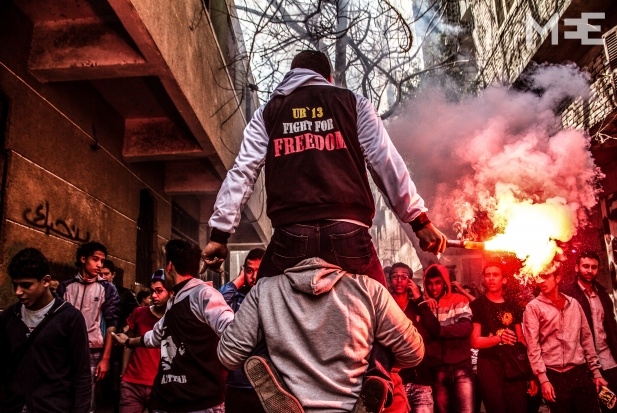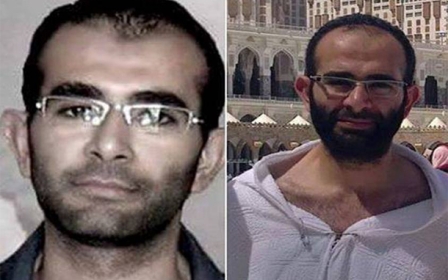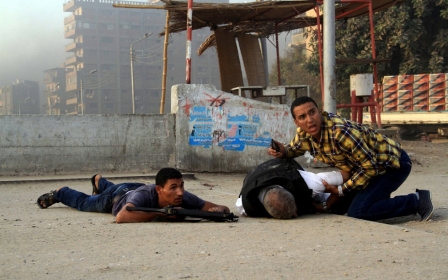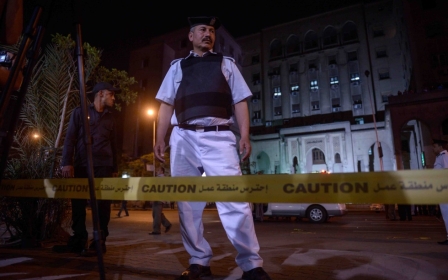In Egypt, the times and protests are a-changin'

Protesting in Egypt is a dangerous activity. Since the toppling of Egypt’s first freely elected leader, Mohamed Morsi, in 2013 after mass protests, president Abdel-Fatah al-Sisi, has tightened restrictions on dissent. Thousands of activists, many of them supporters of the now-banned Muslim Brotherhood, have been rounded up in line with new laws restricting protests. Journalists critical of the government have been harassed and newspapers shuttered.
But political life is ongoing. Almost every week Islamist-led demonstrations against the government take place place in working-class neighbourhoods and residential areas in Cairo. So who are the people risking their lives to attend these rallies and what are their demands? MEE photographer, Belal Darder, who has documented dozens of such demonstrations, reflects on how the tactics of the Islamist-led protest movement are changing:
A year and a half ago, right after the coup, the Brotherhood’s protests were loud, large and public. The leadership would announce on social media, the mosques and schools where demonstrators would gather. Flashing the four-fingered “Rabaa” sign, hundreds of men and women – young and old – marched down busy highways past riot police converging on main squares and government buildings. It was clear to everybody that Muslim Brotherhood members were the ones organising and leading the protests.
Today things are different. A year and a half of clashes, arrests and death sentences has forced the Brotherhood to rethink their tactics. In Cairo now there are ‘no-go’ neighbourhoods like El Zayton; parts of the city where protesters are frequently attacked by the police and where mosques used by the Brotherhood are sealed off to the public. The protests, announced through private groups on Facebook, proceed through alleys and along back streets, and often only number in the dozens. Less young people are present than before and the ones who do are less convinced by the concept of peaceful disobedience. The Muslim Brotherhood leadership has less control of the streets. There are groups of Islamist youth now who try to ambush the police forces.
Ahmed (not his real name), a 20 year-old former member of the Muslim Brotherhood who I spoke to at a recent protest said he longer participated as regularly as he used to. “Right now I only go to the streets on Fridays. I realise that protesting and shouting are useless. Protesting won’t restore the rights of the martyrs who died in the streets, and it won’t get my friends out of prison,” he told me.
“The solution lies in Jihad, that is the only way in which we shall have our rights back, what the Muslim Brotherhood leaders are doing is a diversion from true Islam”.
Another man, Temo Hesham, who harks from a prominent Brotherhood family concurred. “Protesting won’t eliminate the system, it is only a nuisance to the system, but it won’t destroy it” he said. “I think it is total madness to fight bullets back with words, we are losing friends every day, if we continue like this we will disappear in a year!”
A 45-year-old housewife, Nahed el-Shreif, who identified herself as a “conservative Islamist” but not a member of the Brotherhood was more resolute. “The numbers have decreased, but this is what God promised us would happen. Those who stand against injustice and tyranny are always few, protesting and standing against the tyrant…. I believe in that, and I will continue going to the streets.”
Middle East Eye propose une couverture et une analyse indépendantes et incomparables du Moyen-Orient, de l’Afrique du Nord et d’autres régions du monde. Pour en savoir plus sur la reprise de ce contenu et les frais qui s’appliquent, veuillez remplir ce formulaire [en anglais]. Pour en savoir plus sur MEE, cliquez ici [en anglais].




